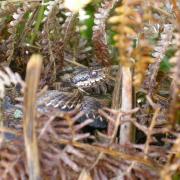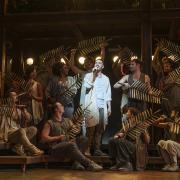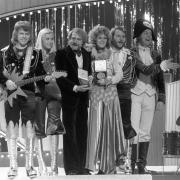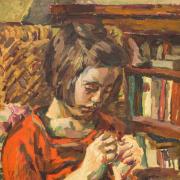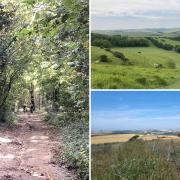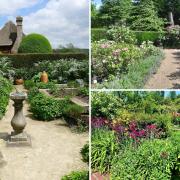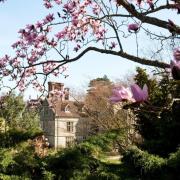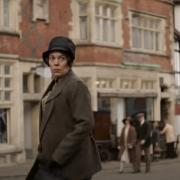Solution for the “Kindred Spirits” piece by Tony Ward in the Sussex Life April issue
Where is it? Kindred Spirits
North of the City, South of the Downs,
houses, cottages, forest and farms,
college and gardens, estate of the Arts,
restoring the old, creating the new.
.
Foundation of a wealthy man,
partner, poet, patron. Building
fantasy worlds in fabric and paint.
Kindred Spirits.
.
The token of his love ...
the footprints of the dancer.
Love lost, replaced, by ...
the footprints of his dogs.
Kindred Spirits.
.
A storm within, a storm without,
garden ravaged, garden restored,
trees replaced, encased, secured.
Kindred Spirits.
.
A red-lipped sofa, a lobster phone,
portraits and poems, financed for a friend.
‘You did your best, rest’ – and after you the bloom
of what you loved and planted still will whisper what you mean.
Kindred Spirits.
Solution – West Dean House and Gardens, West Sussex
Explanation of embedded clues
West Dean House and Gardens are part of the 6,350 acre West Dean Estate. The estate lies a few miles north of Chichester, stretching some six miles on the southern fringe of the South Downs. Its history can be traced back to an entry in the Domesday Book (1086), as a forest and hunting park. The first, medieval, manor house was built in 1603. This was replaced by a Jacobean manor in 1622, then by the first flint mansion in 1738, extended in 1891 and finally ‘surrealised’ in the 1930’s. Besides West Dean House, the estates’ property holdings are significant. Exact counts vary, but there are around 140 houses and cottages, over 100 farm buildings, 12 farms and nearly 2,000 acres of managed woodland. All of this became the property of one very wealthy man, Edward James, a poet, but best remembered for his patronage of the Surrealist art movement in the 1930’s.
“Estate of the Arts” is the realisation of his vision. In 1964, at the age of 57, and twenty years before his death, he transferred everything to a charitable trust, The Edward James Foundation. The Foundation manages his legacy and continues his mission:
I want to establish an educational foundation where creative talents can be discovered and developed, and where one can spread culture through the teaching of crafts and the preservation of knowledge that might otherwise be destroyed or forgotten. (Edward James).
What is more this was not a vision that came to him later in life. In 1939 he had written to Aldous Huxley voicing his concerns that after the war a whole range of craft skills would be lost. In 1971, the Foundation was able to transform the Grade 2* 19th Century flint mansion, West Dean House, into West Dean College. The College is now an internationally recognised centre of excellence for education in the creative arts and conservation, “restoring the old, creating the new”.
The Edward James Foundation also comprises the award-winning West Dean Gardens (open to the public), the West Dean Estate and the West Dean Tapestry Studios. The woodlands on the estate are managed in such a way that they produce a sustainable yield of 1.200 tonnes of woodchips per year to fuel a biomass district heating system, one of the largest such schemes in the U.K. This heats the College complex, the Gardens buildings, Workshops, Textile Studio, a number of estate houses and even an outdoor swimming pool and the Village Church, ‘the warmest in the South of England’. Edward James would have been delighted with such an ecologically sound role for his ‘beloved woods and trees’.
High standards are in fact a feature of all West Dean activities. The Tapestry Studio, one of only two professional Tapestry Weaving Studios in the U.K., uses heritage techniques to produce stunning works of art, keeping alive a 5,000-year-old art form. Artists whose works have been realised with the Studio’s weavers include Henry Moore, John Piper, Martin Creed and, perhaps surprisingly, Tracey Emin – and no, it wasn’t an unmade bed! A long-running project has been a commission from Historic Scotland for the Studio’s weavers to recreate ‘The Mystic Hunt of the Unicorn’, in a series of seven works following the 1495-1505 originals held in the Metropoitan Museum of Art in New York. The fourteen year project was completed in 2015, with the hanging of the final piece as part of the refurbishment of Stirling Castle.
Similarly, the gardens, mainly laid out around the turn of the 19th century were designed to impress. One of the highlights is a 300 foot, Harold Peto designed, pergola. Edward James also added a few surreal touches. “Trees replaced, encased, secured” refers not only to the major restoration that was needed after the ravages of the 1987 and 1990 storms. “Encased” in this case is not a reference to plastic tubing or wire netting to guard against wildlife damage. In the early 1970’s James encapsulated some of his favourite, but dying, trees in fibreglass – a sort of arboreal embalming! The timber has long since rotted away leaving just the fibreglass shell. “Kindred Spirits” in more ways than one. Another surreal touch is to be found in the knapped flint mosaic floor of the Gazebo at the western end of the pergola. Set among the flints are horses’ molar teeth. The author and poet William Plomer, writing in the 1920’s/1930’s, described his visit as being, ‘more like a secret entry into Nepal than a garden’.
So what exactly was Edward James connection with the Surrealism movement in Art history. Stated briefly, without his patronage at least two of the movement’s leading lights may never have got off the ground. The two artists in question were Salvador Dali and Rene Magritte. He was “partner, poet, patron. Building fantasy worlds in fabric and paint”. He was a hands-on patron, passionate and generous:
Money seemed to me to have been given to spend... by spending it in my own way... by fostering any and all creative spirits I could meet with...
James and his protégés were “Kindred Spirits”. The “fantasy world in fabric” refers to his collaboration with Salvador Dali on the design of the famous “Mae West’s lips” sofas, naturally in a bright red fabric. Originally made for his surrealist fantasy Monkton House on the West Dean Estate, one can now be seen in the Brighton Museum and Art Gallery. The Gallery also possesses another wacky collaboration by the pair, the “Lobster Telephone”. During this period, Edward James had first refusal on all Dali’s work and ensured that he was provided with whatever he needed for his work. The “fantasy worlds in paint” refer to Rene Magritte’s paintings. He painted two portraits of Edward James. One, ‘Not to be Reproduced’ , is a head and upper-body back view of James looking into a mirror. The odd thing though is that the image reproduced in the mirror is not of his other side, his face, but again of the same back view. In the other portrait, ‘The Pleasure Principle: Portrait of Edward James’, his head is a fireball. Monkton House, in which he was living instead of in West Dean House itself, he transformed into a complete surrealist fantasy. Monkton House was originally his family’s Lutyen’s designed hunting lodge or ‘dower house’. Perhaps James’s redecorations, including painting the outside walls mauve, would have been a step too far for Edwin Lutyens?
The third verse concerns another rather unusual decorative feature. In 1930 Edward James had married the beautiful Austrian-born ballet dancer and choreographer Tilly Losch. Aged 27, Tilly was 4 years older than James and had already danced with the Vienna Opera, at the Salzburg Festival, and in London and New York. Edward was smitten. He even had a ballet company founded for her, which performed in London and Paris, with Tilly dancing the leading roles.
One day, at home in Monkton House, upon ascending the spiral staircase between their ground floor bathroom and their bedroom, Tilly left a trail of wet footprints. As a “token of his love” James commissioned a carpet for the staircase with “the footprints of the dancer” permanently woven into it. The carpet has lasted but the marriage did not. After just four years there was an acrimonious divorce. Losch partly re-invented herself as an actress on both the English stage and subsequently in a string of Hollywood films. After her second marriage though, to the 6th Earl of Caernarvon, she gave up dance and, ironically, took up painting. Her paintings won acclaim, being purchased by London’s Tate gallery among others. Unsurprisingly none were to be found in Edward James collection.
The verse continues “replaced, by ... the footprints of his dogs.” After the divorce, James no longer wanted the carpet in Monkton House, constantly reminding him of his wife’s infidelity. He moved it to West Dean House and commissioned a replacement featuring the paw-prints of his two Irish wolfhounds. He remarked bitterly the he would rather, ‘commemorate the feet of a faithful creature’. More “Kindred Spirits”.
James now increasingly focussed his attention on supporting or collecting the work of a growing number of mainly ‘surrealist’ artists, past and present. In addition to Salvador Dali and Rene Magritte, these included - Hieronymous Bosch, Leonora Carrington, Giorgio de Chirico, Paul Delvaux, Max Ernst, Leonor Fini, Alberto Giacometti, Paul Klee, Pablo Picasso and Pavel Tchelitchew. James’s collection came to be acknowledged as the most comprehensive collection of surrealist work in private hands. After his death most of the collection was sold at auction at Christie’s.
One of Edward James very first deeds as a patron of the Arts though was not connected with visual art but with poetry. He himself would have liked to have been primarily remembered as a poet, in fact the inscription on his gravestone in St Roche’s Arboretum at West Dean, reads simply, Edward James 1907 – 1984 Poet. Although he didn’t make it into Poet’s Corner in Westminster Abbey himself, we should be grateful that he “financed a friend” who did make it. His poetical friend and fellow student at Christ Church College, Oxford University was one John Betjeman, later to become Sir John Betjeman, Poet Laureate. Edward enjoyed Betjeman’s poems and decided that they should be published. He set up The James Press and published Betjeman’s first collection, Mount Zion, in 1932. This contained such favourites as:
She died in the upstairs bedroom
By the light of the ev’ning star
That shone through the plate glass window
From over Leamington Spa.
(First verse of ‘Death in Leamington’)
The Church’s Restoration
In eighteen-eighty-three
Has left for contemplation
Not what there used to be.
(Opening lines of ‘Hymn’)
My last lines are in fact taken from some of Edward James own last lines. He composed his own epitaph, the opening line of which reads, ‘I have seen such beauty as one man has seldom seen’. Through The Edward James Foundation, “Kindred Spirits” indeed, his vision continues to be celebrated. In his words:
‘You did your best, rest’ – and after you the bloom
Of what you loved and planted still will whisper what you mean.
Acknowledgement of sources
• Simon Jenkins, England’s Thousand Best Houses (p. 792).
• www.westdean.org.uk/about/the-estate
• en.wikipedia.org/wiki/West_Dean_House
• en.wikipedia.org/wiki/Edward_James
• Relevant websites found by searches for ‘West Dean House’, ‘Monkton House West Dean’, ‘Edward James poet’, ‘Tilly Losch’, ‘Tilly Losch footprints’, ‘Surrealist Art at Monkton House’, ‘John Betjeman’s first poetry collection’.



